药明康德合成
- 格式:pdf
- 大小:14.11 MB
- 文档页数:813

经典化学合成反应标准操作Mitsunobu 反应编者:谢军药明康德新药开发有限公司化学合成部目录1.前言 (2)2.醇的翻转 (3)2.1 Mitsunobu 法醇的构型翻转合成方法示例 (7)3.Mitsunobu 醚化反应 (8)3.1 Mitsunobu 法醚的合成方法示例 (9)4.Mitsunobu 氨基取代反应 (10)4.1 Mitsunobu 法利用苯磺酰胺合成胺方法示例 (13)4.2 Mitsunobu 法利用DPPA合成伯胺方法示例 (13)4.3 Mitsunobu 法分子内关环合成相应的环状胺方法示例 (14)4.4 Mitsunobu 法合成丙二烯方法示例 (14)5.Mitsunobu 硫代反应 (16)5.1 Mitsunobu 法合成硫醚方法示例 (16)6.Mitsunobu 卤代反应 (18)6.1 Mitsunobu 法合成卤代物方法示例 (18)7.其他手性翻转试剂 (20)1. 前言1967年,Oyo Mitsunobu 报导了在三苯膦(PPh3)和偶氮二甲酸二乙酯(DEAD)作用下酸和醇缩合成酯的新方法1。
当底物为仲醇的时候,与羟基相连的碳原子的构型会发生翻转。
经过多年的研究和发展,形成了一大类合成方法,我们称之为Mitsunobu 反应。
这类反应被广泛应用在有机合成,特别是天然产物的合成中2。
2.醇的翻转在Mitsunobu 反应中,DEAD 和三苯膦首先生成一个活性的甜菜碱式中间体(betaine intermediate ),这个活性中间体夺取作为亲核试剂的酸的质子并同时活化醇,随后经过S N 2取代,得到手性翻转的酯;将得到的酯水解,其净结果是醇的构型翻转。
R O R OH Ar O23反应在很温和的条件下进行,通常反应温度是在0o C 到室温,大部分基团都不会影响反应。
但亲核试剂质子的pKa 值必须小于甜菜碱式中间体(betaine intermediate )的pKa 值(~13),否则亲核试剂的质子不能被中间体(betaine intermediate )夺取,反应不能进行。

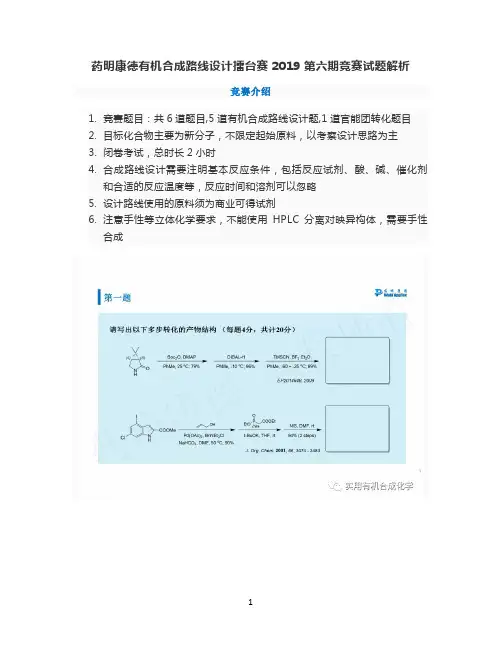
药明康德有机合成路线设计擂台赛2019第六期竞赛试题解析
竞赛介绍
1.竞赛题目:共6道题目,5道有机合成路线设计题,1道官能团转化题目
2.目标化合物主要为新分子,不限定起始原料,以考察设计思路为主
3.闭卷考试,总时长2小时
4.合成路线设计需要注明基本反应条件,包括反应试剂、酸、碱、催化剂
和合适的反应温度等,反应时间和溶剂可以忽略
5.设计路线使用的原料须为商业可得试剂
6.注意手性等立体化学要求,不能使用HPLC分离对映异构体,需要手性
合成。

经典化学合成反应标准操作药明康德新药开发有限公司化学合成部编写前言有机合成研究人员在做化学反应经常碰到常规的反应手边没有现成的标准操作步骤而要去查文献,在试同一类反应时,为了寻找各种反应条件方法也得去查资料。
为了提高大家的工作效率,因此化学合成部需要一份《经典合成反应标准操作》。
在这份材料中,我们精选药物化学中各类经典的合成反应,每类反应有什么方法,并通过实际经验对每类反应的各种条件进行点评,供大家在摸索合成条件时进行比较。
同时每种反应的标准操作,均可作为模板套用于书写客户的final report,这样可以大大节省研究人员书写final report的时间,也相应减少在报告中的文法错误。
另外本版是初版,在今后的工作中我们将根据需要修订这份材料。
药明康德新药开发有限公司化学合成部2005-6-28目录1.胺的合成a)还原胺化b)直接烷基化c)腈的还原d)酰胺的还原e)硝基的还原f)叠氮的还原g)Hoffman降解h)羧酸通过Cris 重排2.羧酸衍生物的合成a)酰胺化的反应b)酯化反应c)腈转化为酯和酰胺d)钯催化的插羰反应e)酯交换为酰氨3.羧酸的合成a)醇氧化b)酯水解c)酰胺的水解d)腈的水解e)有机金属试剂的羰基化反应f)芳香甲基的氧化4.醛酮的合成a)Weinreb 酰胺合成醛酮b)醇氧化c)酯的直接还原d)有机金属试剂对腈加成合成酮5.脂肪卤代物的合成a)醇转化为脂肪溴代物通过PBr3 转化通过PPh3 与CBr4 转化HBr直接交换通过相应的氯代物或磺酸酯与LiBr交换、b)醇转化为脂肪氯代物通过SOCl2转化通过PPh3 与CCl4 转化HCl直接交换c)醇转化为脂肪碘代物通过PPh3 与I2 转化通过相应的氯代物或磺酸酯与NaI交换6.芳香卤代物的合成a)Sandermyyer 重氮化卤代b)直接卤代c)杂环的酚羟基或醚的卤代7.醇的合成a)羧酸或酯的还原b)醛酮的还原c)卤代烃的水解d)吡啶的氧化转位8.酚的合成a)Sandermayer 重氮化反应b)醚的水解c)Bayer-vigerlar 氧化d)硼酸的氧化9.腈的合成a)磺酸酯或卤代烃的取代b)酰胺的脱水c)芳卤代烃的氰基取代10.硝化反应11.醚的合成a)芳香醚的合成酚与烷基卤代烃的直接烷基化Mitsunobu 芳香醚化Buckwald芳香醚化b)脂肪醚的合成醇的醚化12.脲的合成a)胺与异腈酸酯的反应b)用三光气合成脲c)羰基二咪唑(CDI)合成脲d)对硝基苯酚碳酰胺合成脲13.烯烃的合成a)Wittig 反应b)羟基的消除c)Wittig-Horner 反应合成α,β-不饱和酯14.磺酸及磺酰氯的合成a)氯磺化反应合成磺酰氯b)从硫醇合成磺酰氯c)磺化反应15.氨基酸的合成a)Streck 反应合成b)手性氨基酸的合成16.偶联反应a)Suzuki Couplingb)Buckwald 芳胺化,芳酰胺化、c)Heck 反应17.Mitsunobu 反应a)醇的反转b)胺的取代18.脱羟基反应19.酮还原为亚甲基20.氨的保护及脱保护策略a)用碳酰胺作保护基b)苄基保护21.醇的保护及脱保护策略a)用硅醚进行保护b)其他醚类保护22.羧基的保护格氏反应---------------------------------------------------------------------------------------------------------1还原胺化---------------------------------------------------------------------------------------------------------2卤化反应---------------------------------------------------------------------------------------------------------2 Suzuki coupling-------------------------------------------------------------------------------------------------2磺化反应---------------------------------------------------------------------------------------------------------3酯化反应---------------------------------------------------------------------------------------------------------3水解反应---------------------------------------------------------------------------------------------------------3硝化反应---------------------------------------------------------------------------------------------------------4 n-BuLi------------------------------------------------------------------------------------------------------------4 LiAlH4还原-----------------------------------------------------------------------------------------------------4 POCl3的杂环氯代----------------------------------------------------------------------------------------------5 NaH---------------------------------------------------------------------------------------------------------------5 NBS---------------------------------------------------------------------------------------------------------------5m-CPBA ----------------------------------------------------------------------------------------------------------6EDC ---------------------------------------------------------------------------------------------------------------6用三光气成脲---------------------------------------------------------------------------------------------------7芳卤用n-BuLi 处理后与Weinreb 酰胺成酮-----------------------------------------------------------------7Boc 上保护OHH 2NHO OOOOOO OHN HO OHO O ABTo a solution of A (2.72 g, 13.9 mmol) and tetramethylammonium hydroxide pentahydrate (5.62 g, 31.0 mmol) in acetonitrile (270 mL) was added di-tert-butyldicarbonate (3.79 g; 17.4 mmol) and the resulting solution was allowed to stir 18 h at rt and concentrated. The residue was partitioned between Et2O/H2O; the phases were separated and the aqueous phase extracted twice more with Et2O. The aqueous phase was brought to pH 4 with solid citric acid and extracted with CHCl3 (3.x.100 mL). The organic extracts were combined, dried (Na2SO4) and concentrated to afford 2.58 g (63 percent) B as a white foam.ReturnBoc 脱保护OON HOOOOH 2NTert-Butyl 2-(2-methoxyphenoxy)ethylcarbamate (23.8 g, 89 mmol) in dichloromethane (10 ml) was cooled to 0 deg C and stirred as a mixture of trifluoroacetic acid: dichloromethane (1:1, 40 ml) was added dropwise. The mixture was allowed to warm to rt, stirred for 2 hours and concentrated in vacuo. The residue was taken back up in dichloromethane (100 ml) and the solution was washed with saturated aqueous sodium hydrogen carbonate (3*20 ml) and aqueous sodium hydroxide (10percent, 3*20 ml), dried (Na2SO4), filtered and concentrated in vacuo to provide 2-(2-methoxyphenoxy)ethylamine (13 g, 88percent yield) as a light yellow solid.Return格氏反应NCNNOA stirred mixture of magnesium turnings (23.6 g, 0.98 mol) and Et2O (200 mL) under nitrogen is treated with a crystal of iodine and about 5percent of a solution of bromoethane (56.3 ml, 0.75 mol) in Et2O (375 mL). When the reaction starts, the remainder of the bromoethane solution is added, dropwise at a rate sufficient to maintain a gentle reflux. After the addition, stirring is continued for 1 hour. To this solution of ethylmagnesium bromide was slowly added a solution of 4-cyanopyridine (39 g, 0.375 mol) in Et2O (750 ml). The reaction mixture was warmed at reflux for 12 hours, treated with concentrated H2SO4 (125 ml)/H2O (125 ml), and then washed three times with Et2O (250 ml). The aqueous portion was made basic (PH 9) with 15percent NaOH solution and extracted five times with 250 ml portions of Et2O. The combined Et2O extracts were dried (MgSO4), and the solvent was removed under reduced pressure to afford a brown oil (48.4 g, 95percent).Return还原胺化OHO H 2N+HON HA solution of 2-amino-4-ethylphenol (1.00 g. 7.28 mmol), 2-naphthaldehyde (1.13 g, 7.28 mmol), andp-toluenesulfonic acid (0.05 g) in methanol (50 ML) was stirred at room temp for 24 h. To the resultant solution, sodium borohydride (0.82 g, 22 mmol) was added in small portions. After addition was completed, the mixture was stirred at room temperature for 30 min and concentrated under vacuum. The residue was then subjected to column chromatography on silica gel eluted with 10percent ethyl acetate in hexane and followed by recrystallization (aqueous methanol) yielded 450 mg (22percent) of analytically pure product.Return卤化反应O2N O2NBrTo a stirred solution of 8-methyl-1-nitro-naphthalene (10.6g, 56.32 mmol) and iron (III) chloride (0.45 g, 2.77 mmo) in CCl4 (150 ml) heated to 60°C was added dropwise (3.0 ml, 58.23 mmol) of bromine. After one hour, the reaction mixture was poured into saturated NaHCO3 solution, and the layers were separated. The aqueous layer was re-extracted with CH2Cl2. The combined organic layers were dried (MgSO4) and the solvent was removed under reduced pressure. The crude residue was recrystallized from ethanol and the mother liquors were concentrated and then flash chromatographed on silica, eluding hexanes:ethyl acetate (12: 1).ReturnSuzuki couplingBrBOO NH+NH To a mixture of 4-(4,4,5,5-tetramethyl-[1,3,2]dioxaborolan-2-yl)-1H-indole (2 g, 8.2 mnmol) and3-bromobenzene (0.87 ml, 8.3 mmol) in THF (28 ml) were added palladium catalyst Pd(PPh3)4 (284 mg, 0.25 mmol) and the freshly prepared sodium hydroxide solution (984 mg in 9 ml of water).The system was degassed and then charged with nitrogen for three times. The mixture was stirred under nitrogen at 70 °Coil bath for 6 hours. The reaction solution was cooled to room temperature, diluted with ethyl acetate and separated from water layer. The ethyl acetate solution was washed by brine, dried over Na2SO4 and concentrated. The residue was purified on a silica gel column eluding with hexanes: EtOAc 9:1 to give 1.38 g (78%yield) of 4-phenyl-1H-indole as a colorless liquid.Return磺化反应NOFFFNOFFFSOClOChlorosulfonic acid (4.66g, 40 mmol) is added dropwise to a cold (0°C) solution of2,3-dihydro-2-trifluoroacetyl-1H-Benz[de]isoquinoline (2.9g, 8 mmol) in chloroform (800 ml). The resulting solution is stirred at 0°C for 30 minutes. The cold bath is then removed and the solution is stirred at room temperature for 1 hour then cautiously poured into ice water. The organic layer is separated, dried over magnesium sulfate and concentrated to afford the title compound. The crude product is purified by column chromatography eluted with 10% acetic ether in petroleum ether (2.36 g, 81% yield).Return酯化反应HOHO O HOO OA mixture of 4-hydroxymethylnaphthoic acid (10 g, 50 mmol), methanol (300 ml), and concentrate H2SO4(2 ml) was refluxed overnight. The insolubles were filtered off and the filtrate was concentrated. The residue was taken up in ethyl acetate and washed with aqueous NaHCO3 (2*), brine, dried over MgSO4, and concentrated to give a yellow oil. Silica gel column chromatography using ethyl acetate/hexane (1/3) gave the desired product as a yellow oil (3.3 g, 35%yield).Return水解反应OO OHOA solution of 1-Methyl-naphthalene-2-carboxylic acid methyl ester (7.20g, 35mmol) and 2N sodium hydroxide (35ml) in tetrahydrofuran (130ml) was stirred under reflux for 18 hours. The mixture was neutralised using 2N hydrochloric acid, and extracted with dichloromethane (3x). The combined organic solutions were dried (MgSO4), and evaporated under reduced pressure. The crude product was purified by column chromatography on silica gelusing an elution gradient of dichloromethane: methanol (100:0 to 97:3) to afford the title compound as a solid (3.11g, 47.8%yield).Return硝化反应NO 2To a cold (0°C) suspension of 1-methylnaphthalene (5 g, 35.2 mmol) in HNO3 was added H2SO4 (5 ml) dropwise. After stirring the reaction for one hour, the solution was diluted with ethyl acetate and washed with water (3*), aqueous saturated NaHCO3 (2*) and brine, dried over MgSO4, and concentrated. The product was purified by silica gel column chromatography using ethyl acetate: hexane (5: 95) and recrystallized from methanol to give yellow needles (0.22g, 33% yield).Returnn-BuLiEtOCF 3O CF 3O NCTo a dry three-necked round-bottomed flask with an addition funnel and at -78°C under inert atmosphere was charged with anhydrous THF (500 ml). A solution of n-butyllithium (2.5 M in hexane, 88ml, 220 mmol) was added dropwise followed by addition of a solution of acetonitrile (10.43 ml, 200 mmol) in anhydrous THF (100 ml). The internal temperature was maintained below -70°C during the entire addition process. After 2 hr at -78°C a solution of Trifluoro-acetic acid ethyl ester (14.2 g, 100 mmol) in anhydrous THF (30 ml) was added dropwise and the mixture was stirred for 1.5 hr. To the mixture was added acetic anhydride to quench the reaction. The reaction mixture was allowed to warm up to rt. A precipitate was filtered and the filtrate was concentrated to give a brown oil, which was used in the next step without purification.ReturnLiAlH4还原HOHO O OHOHOA solution of 2,3-naphthalenedicarboxylic acid (4.6 g, 0.023 mole) in dry THF (135 ml, warmed to 50° to maintain solution) is added dropwise over 15 minutes to a 1.15 M lithium aluminum hydride solution in THF (45 ml, 0.052 mole). The solution is stirred 3 hours after which TLC indicated consumption of diacid and formation of a new major product. The reaction is quenched carefully with THF-water, then 2N hydrochloric acid (40 ml) is added, and the resulting mixture is extracted 3 times with ether. The combined ether extracts are washed with water (2 times), with saturated sodium bicarbonate solution (1 time), with water, and are dried (sodium sulfate), filtered, and concentrated to give a tan solid (3.67 g). The solid is recrystallized from ethyl acetate giving the title compound (2.91 g, 67.3%yield) as a light tan crystalline material.ReturnPOCl3的杂环氯代NN HOOHN NClClTo a suspension of 2,4-dihydroxy-5,6-dimethylpyrimidine (6.2 g, 0.044 mol) in POCl3 (25 ml) was slowly added N,N-dimethylaniline (6.18 ml, 0.049 mol). The mixture was then refluxed at 125 °C for 3 hours. After this time, the starting material completely dissolved indicating that the reaction was completed.The reaction mixture was cooled and then poured slowly onto ice to quench the POCl3(caution[exothermic]). A precipitate formed, which was filtered and washed with ice-cold water. The precipitate was dried under high vacuum overnight to yield 2,4-dichloro-5,6-dimethyl-pyrimidine (7.2 g, 0.041 mol, 92%yield) as a yellow solid.ReturnNaHHSH 2N Cl +SNH 2Sodium hydride (50% in mineral oil, 5.5 g, 0.11 mol) was added portionwise at 0 °C under a nitrogen atmosphere to a solution of 2-aminobenzenethiol (12 ml, 0.1 mol) in DMF (120 ml). After 0.5 h, benzyl chloride (11.5 ml, 0.1 mol) in DMF (80 ml) was added in 0.5 h. The solution was stirred for 3 h while the temperature was allowed to rise to rt, then it was poured into ice/water (1000 g). The precipitate was filtered, dissolved in ethyl acetate and washed with brine. The organic layer was dried over Na2SO4 and evaporated. The solid obtained was ground in pentane (19.3 g, 90% yield).ReturnNBSNN FCl ClNBSN N FCl ClBrA mixture of 2,4-Dichloro-6-ethyl-5-fluoro-pyrimidine (27.46 g , 0.14mol), AIBN (1.32 g) and n-bromosuccinimide (27.02 g , 0.152mol) in CH2Cl2 (170 ml) was refluxed under a nitrogen atmosphere for 36 h. Then washed by water, the aqueous was extracted by CH2Cl2. The combined organic layer was washed by saturated Na2S2O3 and brine, dried over Na2SO4, and evaporated to give a white solid which was purified by column chromatography eluted with 50% acetic ether in petroleum ether (34 g, 88.6% yield).Return氢化反应O ONH OONH2Cl ClA mixture of ethyl 3-(N-benzylamino)-3-methylbutyrate hydrochloride (25g, 0.1 mol) and 10percent Pd-C (2g) in 250 ml of dried alcohol was hydrogenated under 55 psi H2 for four days. The reaction medium was then filtered and evaporated under reduced pressure to provide an amber oil which gradually crystallized upon standing (18 g, 100% yield).Returnm-CPBAS NH2SNH2OA solution of 85% m-chloroperoxybenzoic acid (19 g, 94 mmol) in CH2Cl2 (350 ml)was added at –5 –0 °C to a solution of 2-Benzylsulfanyl-phenylamine (19 g, 88 mmol) in CH2Cl2 (400 ml). The mixture was allowed to warm to rt in 3 h, then it was washed with a 5% Na2S2O3 solution, 10% NaHCO3 solution and brine. The organic layer was dried over Na2SO4, and evaporated. The solid was ground in pentane (19 g, 95% yield).ReturnEDCNH2OHNOO+HOHOHNOOTo a 0°C mixture of Boc-L-tyrosine (2.04 g, 7.26 mmol) and amylamine (0.63 gl, 7.26 mmol) in methylene chloride (30 ml) is added 1-(3-dimethylaminopropyl)-3-ethylcarbodiimide (EDC) (1.53 g, 9.9 mmol). Thewhite mixture is stirred at 0°C for 5 min and at room temp for 23 hrs. The resulting solution is diluted with methylene chloride (30 ml) and washed successively with 0.5 M HCl (40 ml), water (20 ml) and sat aq sodium bicarbonate (25 ml). The organic phase is dried over magnesium sulfate and concentrated to a foam (1.84 g, 72.4%yield), sufficiently pure to carry into the next step. An analytical sample is obtained by HPLC.Return三光气成脲NH 2ONO 2Si O Cl Cl ClO O Cl Cl ClO 2NHN H NO OHOHNO 2+To a solution of 2-(tert-butyldimethylsilyloxy)-4-nitroaniline (200 mg, 0.75 mmol) in toluene (10 ml) triethylamine (0.13 ml, 1.64 mmol) and triphosgene (88.4 mg, 0.3 mmol) were added. The reaction mixture was stirred at 70 °C for 2 hours, then cooled to room temperature. Then more 2-(tert-butyldimethylsilyloxy)-4-nitroaniline (200 mg, 0.75 mmol) was added. The resulting mixture was allowed to stir at 70 °C for 48 hours then cooled to room temperature. The reaction mixture was partitioned between water and ethyl acetate. The combined organic phase was washed with brine, dried over MgSO4 and filtered. Removal of solvent at reduced pressure and chromatography of the resulting oil on silica gel (hexane: ethyl acetate, 10:1) gave 1,3-Bis-(2-hydroxy-4-nitro-phenyl)-urea (130 mg, 31%yield).Return芳卤用n-BuLi处理后与Weinreb酰胺成酮N FFFFNOO+FFFO NFTo a solution of diisopropylamine (17.69 ml, 0.135 mole) in THF (200 ml) at –78°C under argon was added n-butyllithium (54.0 ml, 2.5M in hexane, 0.135 mole), followed after 5 min by dropwise a solution of 2-fluoro-4-methylpyridine (10 g, 0.090 mole) in THF (20 ml). After stirring for 15 min at –78°C, a solution of N-methoxy-N-methyl-3-trifluoromethylbenzamide (23.08 g, 0.099 mole) in THF (10 ml) was added dropwise. After stirring for more 5 min, the reaction was allowed to warm to 0°C and quenched by pouring into water (400 ml) and ethyl acetate (400 ml). The layers were separated, and the aqueous layer washed with ethyl acetate (200 ml). The ethyl acetate extracts were combined, dried over anhydrous sodium sulfate, filtered, and concentrated to an oil which was chromatographed on silica gel with 20percent ethyl acetate in hexane to give 21.6 g of 2-(2-Fluoro-pyridin-4-yl)-1-(3-trifluoromethyl-phenyl)-ethanone (84.8%yield).Return。

经典化学合成反应标准操作钯催化的插羰反应编者:钱占山药明康德新药开发有限公司化学合成部Contents1.前言...........................................................................2-3 2.插羰反应制备羧酸及其衍生物.......................................4-15 3.插羰反应制备羧酸实验操作..........................................15-16 4.插羰反应制备羧酸酯实验操作....................................16-19 5.插羰反应制备酰胺实验操作.......................................19-20 6.插羰反应制备醛 (20)7.插羰反应制备醛实验操作………………………………………21-22 8.插羰反应制备酮………………………………………22-30 9.插羰反应制备酮实验操作………………………………………30-311. 前言在有机合成中,钯催化的反应是一类特别有用的反应,它提供了一种形成碳-碳键的独特的方法。
这类反应的优点:1、不需要加入其他氧化剂催化;2、只需催化量的钯催化剂。
钯催化的插羰反应是这类反应中应用最为广泛的反应之一,在这里我们将重点介绍它。
众所周知,在格氏反应中单质镁金属与带有sp3杂化碳原子的有机卤化物(烷基卤化物)反应要比带有sp2杂化碳原子的有机卤化物(芳基和烯基卤化物)反应更容易。
而与此相反,钯的络合物与含有sp2杂化碳原子的有机卤化物反应更容易。
换句话说,烯基和芳基卤化物非常容易与Pd(0)发生氧化加成反应,从而生成含有钯-碳б-键的络合物中间体1;然后,不饱和化合物(例如:烯烃、共轭二烯、炔烃和一氧化碳等)插入到钯-碳键之间;最后,经过还原消去或者β-氢消去反应生成相应的目标化合物。

Mitsunobu-反应经典化学合成反应标准操作Mitsunobu 反应编者:谢军药明康德新药开发有限公司化学合成部目录1.前言 (2)2.醇的翻转 (3)2.1 Mitsunobu 法醇的构型翻转合成方法示例 (7)3.Mitsunobu 醚化反应 (8)3.1 Mitsunobu 法醚的合成方法示例 (9)4.Mitsunobu 氨基取代反应 (10)4.1 Mitsunobu 法利用苯磺酰胺合成胺方法示例 (13)4.2 Mitsunobu 法利用DPPA合成伯胺方法示例 (13)4.3 Mitsunobu 法分子内关环合成相应的环状胺方法示例 (14)4.4 Mitsunobu 法合成丙二烯方法示例 (14)5.Mitsunobu 硫代反应 (16)5.1 Mitsunobu 法合成硫醚方法示例 (16)6.Mitsunobu 卤代反应 (18)6.1 Mitsunobu 法合成卤代物方法示例 (18)7.其他手性翻转试剂 (20)1. 前言1967年,Oyo Mitsunobu 报导了在三苯膦(PPh3)和偶氮二甲酸二乙酯(DEAD)作用下酸和醇缩合成酯的新方法1。
当底物为仲醇的时候,与羟基相连的碳原子的构型会发生翻转。
经过多年的研究和发展,形成了一大类合成方法,我们称之为Mitsunobu 反应。
这类反应被广泛应用在有机合成,特别是天然产物的合成中2。
2.醇的翻转在Mitsunobu 反应中,DEAD 和三苯膦首先生成一个活性的甜菜碱式中间体(betaine intermediate ),这个活性中间体夺取作为亲核试剂的酸的质子并同时活化醇,随后经过S N 2取代,得到手性翻转的酯;将得到的酯水解,其净结果是醇的构型翻转。
R O R OH Ar O23反应在很温和的条件下进行,通常反应温度是在0o C 到室温,大部分基团都不会影响反应。
但亲核试剂质子的pKa 值必须小于甜菜碱式中间体(betaine intermediate )的pKa 值(~13),否则亲核试剂的质子不能被中间体(betaine intermediate )夺取,反应不能进行。
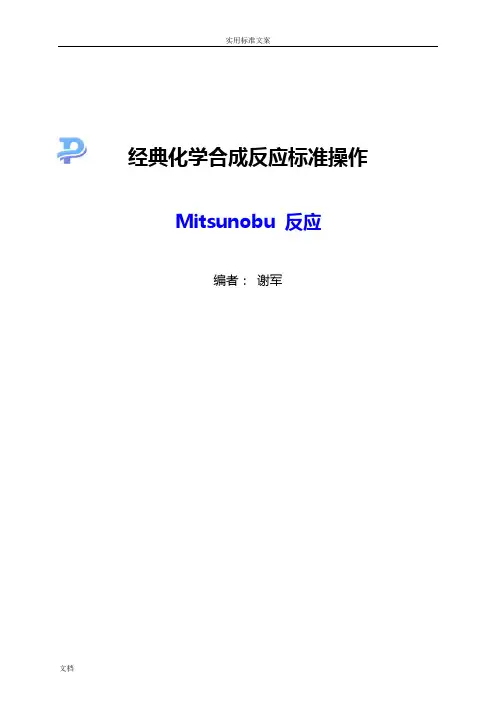
实用标准文案经典化学合成反应标准操作Mitsunobu 反应编者:谢军药明康德新药开发有限公司化学合成部目录1.前言 (2)2.醇的翻转 (3)2.1 Mitsunobu 法醇的构型翻转合成方法示例 (7)3.Mitsunobu 醚化反应 (8)3.1 Mitsunobu 法醚的合成方法示例 (9)4.Mitsunobu 氨基取代反应……………………………………………104.1 Mitsunobu 法利用苯磺酰胺合成胺方法示例…………………………………134.2 Mitsunobu 法利用DPPA合成伯胺方法示例……………………………………134.3 Mitsunobu 法分子内关环合成相应的环状胺方法示例…………………………144.4 Mitsunobu 法合成丙二烯方法示例………………………………………………145.Mitsunobu 硫代反应…………………………………………………1 65.1 Mitsunobu 法合成硫醚方法示例 (16)6.Mitsunobu 卤代反应…………………………………………………186.1 Mitsunobu 法合成卤代物方法示例 (18)7.其他手性翻转试剂 (20)1. 前言1967年,Oyo Mitsunobu 报导了在三苯膦(PPh3)和偶氮二甲酸二乙酯(DEAD)作用下酸和醇缩合成酯的新方法1。
当底物为仲醇的时候,与羟基相连的碳原子的构型会发生翻转。
经过多年的研究和发展,形成了一大类合成方法,我们称之为Mitsunobu 反应。
这类反应被广泛应用在有机合成,特别是天然产物的合成中2。
2.醇的翻转在Mitsunobu 反应中,DEAD 和三苯膦首先生成一个活性的甜菜碱式中间体(betaine intermediate ),这个活性中间体夺取作为亲核试剂的酸的质子并同时活化醇,随后经过S N 2取代,得到手性翻转的酯;将得到的酯水解,其净结果是醇的构型翻转。
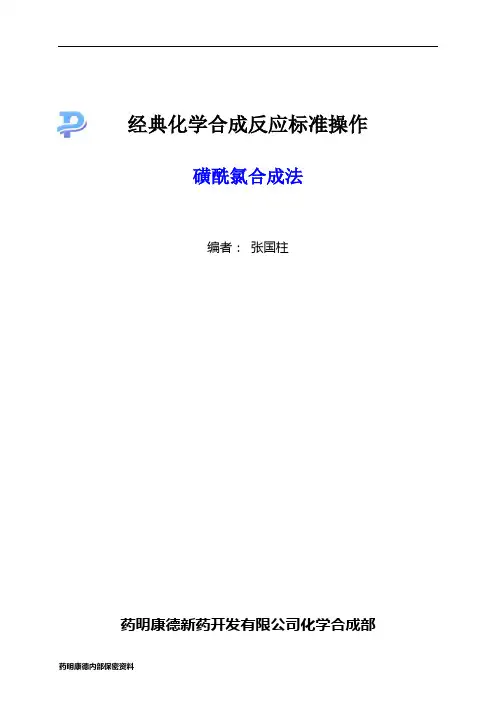
经典化学合成反应标准操作磺酰氯合成法编者:张国柱药明康德新药开发有限公司化学合成部目录1. 前言 (2)2. 芳香磺酰氯的制备 (2)2. 1直接氯磺化法制备芳香磺酰氯 (2)2. 2芳香磺酸或盐氯化制备芳香磺酰氯 (3)2. 3芳香硫醇及相关衍生物氯代、氧化合成芳香磺酰氯 (8)2. 4. 芳香硫醇的制备 (11)2. 5 Sandermeyer 反应由芳胺合成芳香磺酰氯 (13)3. 脂肪磺酰氯的制备3. 1 烷基硫醇的合成及通过烷基硫醇合成脂肪磺酰氯 (14)3. 2 通过烷基硫脲合成脂肪磺酰氯 (16)3. 3 通过烷基异硫氰酸酯合成芳香磺酰氯 (17)3. 4 通过羧酸硫醇酯合成芳香磺酰氯 (17)3. 5 脂肪磺酰氯合成反应示例 (18)参考文献: (20)1. 前言磺酰氯是有机化学中非常重要的一类化合物,它们可以作为重要的中间体进行修饰。
比如,同胺类化合物作用生成的磺胺类药物是优良的化学治疗剂,开始应用于20世纪30年代。
它们能抑制多种细菌,如链球菌、葡萄球菌、肺炎球菌、脑膜炎球菌、痢疾杆菌等的生长和繁殖,因此常用以治疗由上述细菌所引起的疾病。
高碳烷基磺酸钠类化合物则是优良的合成洗涤剂。
磺酰氯主要分为脂肪族磺酰氯和芳香族磺酰氯。
芳香磺酰氯的来源有以下几类:1)由硫酚,各种硫醚在酸性溶剂中导入氯气制得;2)芳香磺酸类化合物在氯化试剂作用下形成;3)磺化反应。
脂肪族磺酰氯的来源主要是硫醇或相关衍生物氯代或氧化。
因此,作为磺酰氯的重要前体,磺酸和硫醇类化合物的引入,也是合成磺酰氯基团的重要手段。
2. 芳香磺酰氯的制备芳香磺酰氯的制备一般分为以下几种方法,直接用氯磺化法制备芳香磺酰氯。
芳香磺酸或盐经氯化制备芳香磺酰氯。
芳香硫醇及相关衍生物氯化,氧化合成芳香磺酰氯。
Sandermeyer反应由芳胺合成芳香磺酰氯。
2. 1直接氯磺化法制备芳香磺酰氯氯磺酸是一类比较常用的直接氯磺化试剂,氯磺酸的活性比浓硫酸大,反应温度较低,同时可以直接得磺酰氯。
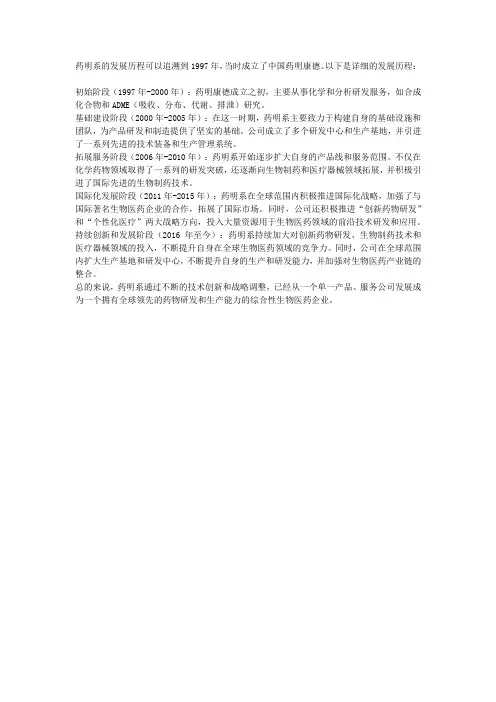
药明系的发展历程可以追溯到1997年,当时成立了中国药明康德。
以下是详细的发展历程:
初始阶段(1997年-2000年):药明康德成立之初,主要从事化学和分析研发服务,如合成化合物和ADME(吸收、分布、代谢、排泄)研究。
基础建设阶段(2000年-2005年):在这一时期,药明系主要致力于构建自身的基础设施和团队,为产品研发和制造提供了坚实的基础。
公司成立了多个研发中心和生产基地,并引进了一系列先进的技术装备和生产管理系统。
拓展服务阶段(2006年-2010年):药明系开始逐步扩大自身的产品线和服务范围。
不仅在化学药物领域取得了一系列的研发突破,还逐渐向生物制药和医疗器械领域拓展,并积极引进了国际先进的生物制药技术。
国际化发展阶段(2011年-2015年):药明系在全球范围内积极推进国际化战略,加强了与国际著名生物医药企业的合作,拓展了国际市场。
同时,公司还积极推进“创新药物研发”和“个性化医疗”两大战略方向,投入大量资源用于生物医药领域的前沿技术研发和应用。
持续创新和发展阶段(2016年至今):药明系持续加大对创新药物研发、生物制药技术和医疗器械领域的投入,不断提升自身在全球生物医药领域的竞争力。
同时,公司在全球范围内扩大生产基地和研发中心,不断提升自身的生产和研发能力,并加强对生物医药产业链的整合。
总的来说,药明系通过不断的技术创新和战略调整,已经从一个单一产品、服务公司发展成为一个拥有全球领先的药物研发和生产能力的综合性生物医药企业。
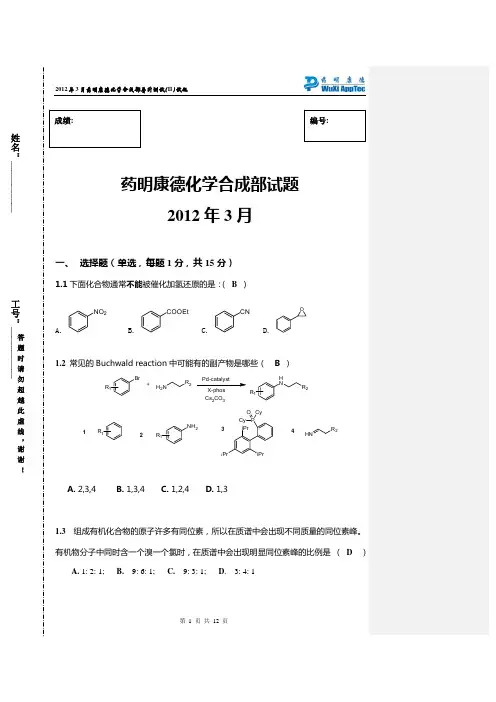

经典化学合成反应标准操作其他方法合成胺编者:刘国超药明康德新药开发有限公司化学合成部1.Curtius 重排合成胺及相应的衍生物Curtius 重排是一种常用的将羧酸转化为少一个碳的胺及相应衍生物的方法。
其机理如下RO ClR O N 3R OR-N=C=O+N 22O R-NH 2R-NHCbzR-NHBocR'NH O NHR'RHNRO OH首先酰氯被转化为酰基叠氮,其加热重排脱去一分子氮气后得到相应的异氰酸酯,异氰酸酯水解或和其他亲核试剂反应得到胺及相应的衍生物。
早期的合成方法都是将酸转变为相应的酰氯,再生成酰基叠氮。
后来Shiori (JACS ,1972,94,6203)等人报道了DPPA 和羧酸在室温下很温和的生成酰基叠氮,可一锅法合成胺。
若直接用过量的醇或直接用醇做溶剂可得到相应的胺的衍生物。
如用苄醇可一步得到Cbz 保护的胺; 用叔丁醇可一步得到Boc 保护的胺。
RO OHR-N=C=OR-NH 2P O N 3PhO PhORO N 3H 2ORO OHR-N=C=OP O N 3PhO PhORO N 3R'OHR N HO O R'一般情况下,用此方法直接做胺并不是一个好的方法,特别是制备烷基胺,其主要有两个原因:一是得到的胺特别是烷基胺不易纯化;二是加水分解异氰酸酯时得到的胺会和未反应完全的异氰酸酯反应成脲,因此分解时要剧烈搅拌, 另外也有人使用稀酸水解异氰酸酯得到相应的胺的盐酸盐。
1.1 酰基叠氮重排合成胺示例F FOCO2H1. SOCl2. NaN3, H2O, acetoneF FONH22,6-difluoro-4-methoxyphenyl carboxylic acid (2.00 g, 10.6 mmol) was dissolved in thionyl chloride (16 mL). One drop of DMF was added and the mixture was heated to reflux for 2 h. The crude mixture was evaporated to dryness and the residue was dissolved in 5mL acetone.A solution of sodium azide (970 mg, 14.9 mmol) in water (2 mL ) was added dropwise at room temperature. After 30 min, water (10 mL) was added and the solution was extracted with toluene (50 mL). The organic layers were dried over sodium sulfate and heated to reflux for 30 min. Then 10 mL of a 45% sodium hydroxide solution was added and the mixture was heated for a further 30 min. The organic layer was separated, dried over sodium sulfate and evaporated. The residue was purified by column chromatography (dichloromethane) to yield 660 mg (39%) of the title compound.Reference:Tetrahedron Lett., 2004, 45, 95 - 98.1.2 使用DPPA合成胺示例CO2HOO 21. DPPA/THFNH2OONO278%2-benzyloxy-3-methoxy-4-nitroanilin acid (27.9 g, 91.8 mmol) was dissolved in THF (400 mL) and treated with Et3N (30 mL). Diphenylphosphoryl azide (26.5 g, 96.4 mmol) was added dropwise and the reaction mixture was stirred for 3 h at 25 o C. H2O (150 mL) was added and the reaction mixture was refluxed for 2 h. The solvent was removed in vacuo and the residue was treated with saturated aqueous K2CO3 (100 mL), diluted with H2O (500 mL), and extracted with EtOAc (2 × 500 mL). The combined organic extracts were washed with saturated aqueous NaCl (500 mL), dried (Na2SO4), and concentrated in vacuo. The crude residue was purified by flash chromatography (SiO2, 25% EtOAc−hexanes) to afford the titlecompound (19.5 g, 78%) as a yellow solid.Reference:J. Am. Chem. Soc., 2004, 126, 8396 - 8398.叠氮酰胺在H2O里加热重排成胺还是有一些报道的。
经典化学合成反应标准操作酰胺及酰亚胺的合成编者:齐志奇药明康德新药开发有限公司化学合成部目录1. 前言 (3)2. 羧酸与胺的缩合酰化反应 (3)2.1活性酯法 (3)2.1.1应用氯甲酸乙酯或异丁酯活性酯法合成酰胺示例 (5)2.1.2应用氯甲酸乙酯或异丁酯活性酯法合成伯酰胺示例 (5)2.1.3应用羰基二咪唑合成Weinreb酰胺示例 (6)2.1.4应用的磺酰氯合成酰胺示例 (6)2.1.5应用Boc酸酐合成伯酰胺示例 (7)2.2碳二亚胺类缩合剂法 (7)2.2.1应用DCC缩合法合成酰胺示例 (9)2.2.2应用DIC缩合法合成酰胺示例 (10)2.2.3应用EDC缩合法合成酰胺示例一(二氯甲烷为溶剂) (10)2.2.4应用EDC缩合法合成酰胺示例二(DMF为溶剂) (11)2.3 鎓盐类的缩合剂法 (11)2.3.1应用HATU/TBTU为缩合剂合成酰胺示例 (13)2.3.2应用BOP为缩合剂合成酰胺示例 (14)2.3.3应用PyBOP为缩合剂合成酰胺示例一(常规) (14)2.3.4应用PyBOP为缩合剂合成酰胺示例二(用于合成伯酰胺) (15)2.4 有机磷类缩合剂 (15)2.4.1应用DPP-Cl为缩合剂合成酰胺示例 (16)2.4.2应用DPPA为缩合剂合成酰胺示例 (16)2.4.3应用BOP-Cl为缩合剂合成酰胺示例 (17)2.5.1应用三苯基磷-多卤代甲烷合成酰胺示例 (18)2.5.2应用三苯基磷-六氯丙酮合成酰胺示例 (18)2.5.3应用三苯基磷-NBS合成酰胺示例 (19)3. 氨或胺与酰卤的酰化反应 (19)3.1酰卤的制备示例 (20)3.5.1应用二氯亚砜合成酰氯示例 (20)3.5.2用草酰氯合成酰氯示例 (21)3.5.3用三氯均三嗪合成酰氯示例 (21)3.5.4用三氟均三嗪合成酰氟示例 (22)3.1应用酰卤的合成酰胺 (22)3.5.1应用酰氯合成酰胺示例(有机碱) (22)3.5.2应用酰氯合成酰胺示例(无机碱) (22)3.5.3应用酰氟合成酰胺示例 (24)4. 氨或胺与酸酐的酰化反应 (24)4.2酸酐合成酰胺示例 (25)5. 其他缩合方法 (25)1. 前言酰胺化是有机合成中最基本,也是最重要的合成方法之一。
经典化学合成反应标准操作Mitsunobu 反应编者:谢军药明康德新药开发有限公司化学合成部目录1.前言 (2)2.醇的翻转 (3)2.1 Mitsunobu 法醇的构型翻转合成方法示例 (7)3.Mitsunobu 醚化反应 (8)3.1 Mitsunobu 法醚的合成方法示例 (9)4.Mitsunobu 氨基取代反应 (10)4.1 Mitsunobu 法利用苯磺酰胺合成胺方法示例 (13)4.2 Mitsunobu 法利用DPPA合成伯胺方法示例 (13)4.3 Mitsunobu 法分子内关环合成相应的环状胺方法示例 (14)4.4 Mitsunobu 法合成丙二烯方法示例 (14)5.Mitsunobu 硫代反应 (16)5.1 Mitsunobu 法合成硫醚方法示例 (16)6.Mitsunobu 卤代反应 (18)6.1 Mitsunobu 法合成卤代物方法示例 (18)7.其他手性翻转试剂 (20)1. 前言1967年,Oyo Mitsunobu 报导了在三苯膦(PPh3)和偶氮二甲酸二乙酯(DEAD)作用下酸和醇缩合成酯的新方法1。
当底物为仲醇的时候,与羟基相连的碳原子的构型会发生翻转。
经过多年的研究和发展,形成了一大类合成方法,我们称之为Mitsunobu 反应。
这类反应被广泛应用在有机合成,特别是天然产物的合成中2。
2.醇的翻转在Mitsunobu 反应中,DEAD 和三苯膦首先生成一个活性的甜菜碱式中间体(betaine intermediate ),这个活性中间体夺取作为亲核试剂的酸的质子并同时活化醇,随后经过S N 2取代,得到手性翻转的酯;将得到的酯水解,其净结果是醇的构型翻转。
ROROH ArO23反应在很温和的条件下进行,通常反应温度是在0o C 到室温,大部分基团都不会影响反应。
但亲核试剂质子的pKa 值必须小于甜菜碱式中间体(betaine intermediate )的pKa 值(~13),否则亲核试剂的质子不能被中间体(betaine intermediate )夺取,反应不能进行。
经典化学合成反应标准操作Suzuki 反应编者:刘德军、武伟药明康德新药开发有限公司化学合成部目录1 前言 (3)1.1 Suzuki反应的通式 (3)1.2 Suzuki反应的机理 (3)1.3 Suzuki反应的特点及研究方向 (4)2 有机硼试剂的合成 (4)2.1 通过金属有机试剂制备单取代芳基硼酸 (4)2.1.1 通过Grinard试剂制备单取代芳基硼酸示例 (4)2.1.2 通过有机锂试剂制备单取代芳基硼酸示例 (5)2.2 通过二硼烷频哪酯制备芳基硼酸酯 (6)2.2.1 通过二硼烷频哪酯制备芳基硼酸酯示例(一) (9)2.2.2 通过二硼烷频哪酯制备芳基硼酸酯示例(二) (10)2.2.3 通过芳基硼酸转化为芳基硼酸酯 (10)2.3 烯基硼酸酯的制备 (10)2.4 烷基硼酸酯的制备 (10)3 催化剂的制备 (11)3.1 Pd(PPh3)4的制备 (11)3.2 Pd(PPh3)2Cl2的制备 (12)3.3 Pd(dppf)Cl2的制备 (12)4Suzuki偶联的应用 (12)4.1 普通的芳卤和芳基硼酸的Suzuki偶联 (13)4.1.1 Pd(PPh3)4-Na2CO3-DME-H2O 体系Suzuki偶联反应示例 (14)4.2 大位阻芳基硼酸参与Suzuki偶联反应 (14)4.3 含敏感功能团的芳基硼酸(酯)参与Suzuki偶联反应 (15)4.3.1 芳基硼酸频哪酯和芳基卤代物的Suzuki偶联 (16)4.3.2 带着酯基底物的Suzuki偶联反应示例(一) (16)4.3.3 带着酯基底物的Suzuki偶联反应示例(二) (17)4.4 杂环芳基硼酸参与Suzuki偶联反应 (17)4.5烷基硼酸参与Suzuki偶联反应 (18)4.6烯基硼酸参与Suzuki偶联反应 (19)4.7 Triflate参与Suzuki偶联反应 (19)4.7.1芳基的三氟甲基磺酸酯与芳基硼酸偶联示例 (20)4.7.2 芳基的Triflate与芳基硼酸偶联示例 (20)4.8 芳基氯参与Suzuki偶联反应 (21)4.8.1钯催化下芳基氯参与Suzuki偶联反应示例(一) (21)4.8.2钯催化下芳基氯参与Suzuki偶联反应示例(二) (22)4.9 镍催化体系用于Suzuki偶联反应 (22)4.9.1 NiCl2(dppf)和n-BuLi催化下芳基氯参与Suzuki偶联反应示例 (22)4.10 其他方法 (23)4.10.1 直接Pd/C用于Suzuki偶联反应示例 (23)4.10.2 直接Pd(OAc)2用于Suzuki偶联反应示例 (23)1 前言1.1 Suzuki 反应的通式在钯催化下,有机硼化合物与有机卤素化合物进行偶联反应,这就提供了一类常用和有效的合成碳-碳键化合物的方法,我们称之为Suzuki 偶联反应,或Suzuki-Miyaura 偶联反应。